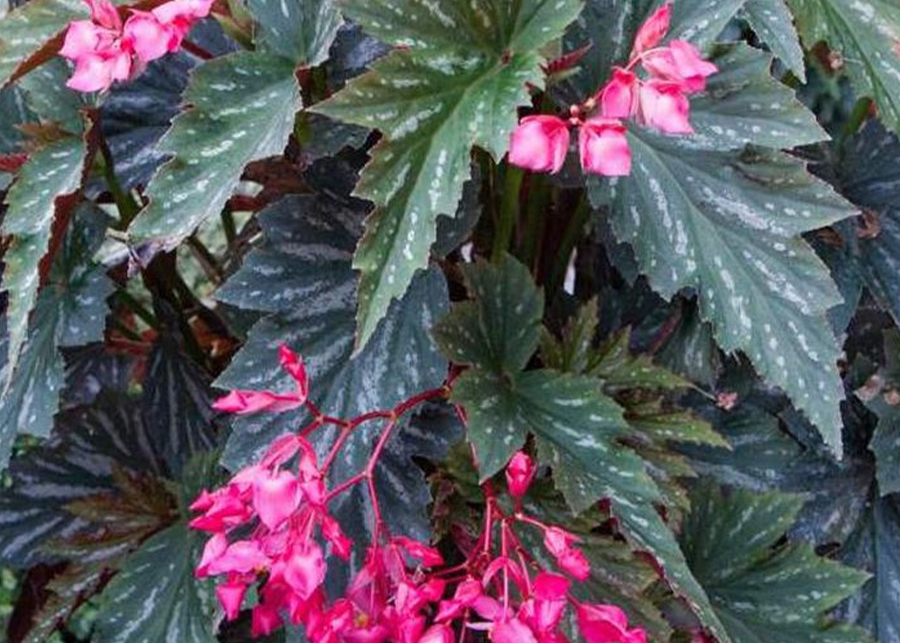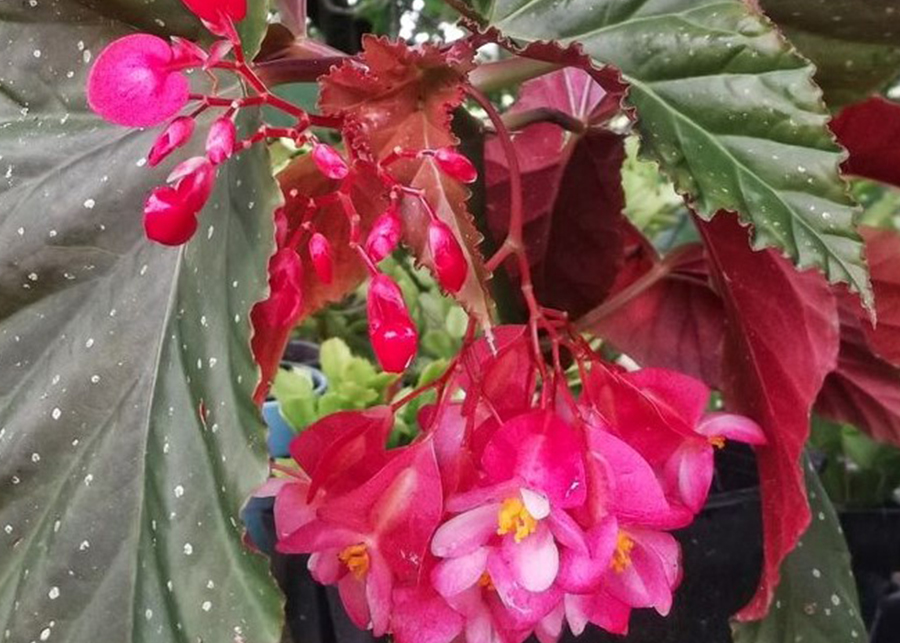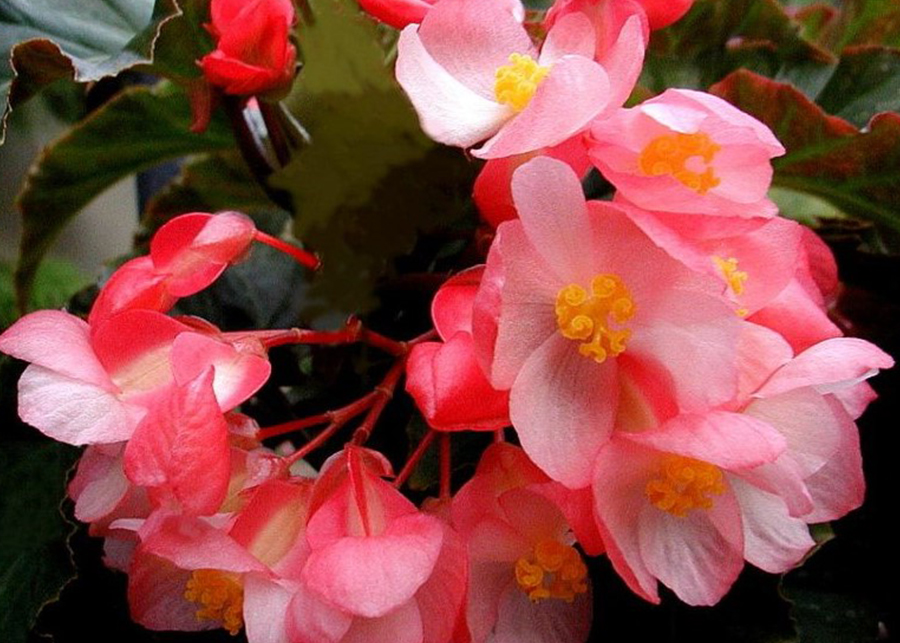You’ve probably seen this plant before, it’s available in most garden centers and is a very common houseplant. It has handsome “wings” (more like crinkles), and that’s where the name angel wing comes from. It’s also known as a Rex Begonia as it forms a rosette of leaves that are thick and fleshy, reminding of a Rex begonia. Ironically, it is not related to the Begonia family at all.
The Angel-Wing Begonia is a perennial, a type of begonia with a cane-like stem that is tough and bamboo-like. It can grow up to 10 feet tall, but is best kept under control. When properly grown, it can be a beautiful houseplant.

Cane-type begonias are easy to grow
Cane- type begonias are a very popular choice for the beginner gardener. They grow easily and are free flowering. They are very attractive plants that will build your confidence. Many people prefer the silvery-flecked leaves and the purple tones of the flowers.
Despite their slender appearance, cane- type begonias can reach six feet or more. They grow with a bamboo-like stem and flower in clusters. Some of the species flower all year round, making them a great choice for indoor or outdoor gardening.
They bloom year-round
If you want your Angel -Wing Begonia to bloom year-round, it will need to be properly cared for. It should be watered only as needed, and should never be overwatered. Whether growing in a pot or a garden bed, allow the top layer of soil to dry out completely before watering again. In colder climates, trimming the plant back to three to five inches above the soil can provide a neater appearance. You can also propagate your Angel-Wing Begonia by stem cuttings, but make sure to avoid cuttings that are blooming. Flowers can suck up water and lead to browning.
Angel-Wing Begonias should be pruned at least once a year to keep them healthy and happy. The best time to prune them is during the spring and summer months. Pinch off the top half of the plant so that the plant can focus on developing roots.
During pruning, make sure to clean the shears thoroughly between each cut to avoid disease transfer. Pine- Sol or Lysol are good cleaning solutions for shears, but never use abrasives on metal blades.
They are resistant to root rot
As a result, this plant is a good choice for a tropical or subtropical garden. These plants can grow in a variety of climates and can tolerate dry and warm weather. This plant does not respond well to misting and needs frequent watering. The best way to water angel wing begonias is by placing them in a tray of pebbles filled with water. Make sure to keep them a few inches above the water to prevent root rot.
Angel- Wing Begonias require regular watering, but excessive watering can lead to brown leaves and a weak flower. Water the plant no more than every three to five days to avoid this problem. When you are not sure how much to water, check the soil and the foliage to see if the plant is dry. If the leaves are brown or singed, the plant is receiving too much light. If this is the case, try repositioning the plant away from the window or switching to another window. You can also use an insecticidal soap spray on the entire plant. This prevents the spread of disease. Remember to keep your angel wing begonia away from cats and dogs. They are toxic to cats and dogs. If you have a pet, be sure to keep it in a place where they cannot access it.
They are susceptible to fungal disease
Angel-Wing Begonia can be susceptible to fungal diseases such as root rot and powdery mildew. They need a light, aerated soil with a good level of organic matter. For best results, use a peat moss and vermiculite mix or peat moss and perlite. This mixture will provide the plants with moisture and provide the proper nutrients for blooming.
Powdery mildew is a common fungal disease that affects the leaves of angel-wing begonia. Powdery mildew can be easily treated by removing any infected leaf litter or vegetation, and using a fungicide designed for the problem. Botrytis is another fungal disease that causes brown spots on the leaves of angel- wing begonia and can eventually kill the plant. Botrytis can be treated by trimming back the affected plant or stopping overhead watering.

They prefer moist soil
Angel-Wing Begonia are easy to grow and can be grown in a variety of different soil conditions. This plant will need moist soil and a bright, indirect light environment. This plant can be propagated from cuttings and should be planted in spring or early summer.
To grow Angel-Wing Begonia successfully, you need to provide it with a moist soil that drains well. You can add organic compost to the soil to provide nutrients for your plant. Alternatively, you can use a custom fertilizer, which contains more phosphorus than nitrogen.
They need phosphorus-rich fertilizer
If you are considering growing angel-wing begonia, you’ll need to find a phosphorus-rich fertilizer for your plant. These plants can become leggy during their growth, so you need to use a fertilizer that contains phosphorus. They will also need additional water, and they should be kept in dappled shade.
Watering your plant is very important for an angel-wing begonia. It likes medium to high moisture levels, but not excessively. You should be sure that the soil is not too dry, or else it will suffer from stress and possibly even die. You can test the soil moisture with a fingertip or a special soil moisture tester to determine how much water the plant needs.
Angel Wing Begonia Result
Angel-wing begonias are some of the most beautiful tropical plants to grow in the home, but they are a bit on the temperamental side. While they love bright light, they can handle low moisture and do not like temperatures under 40 degrees. Overall, a well grown angel wing begonia will be healthy and delightful to look at.



